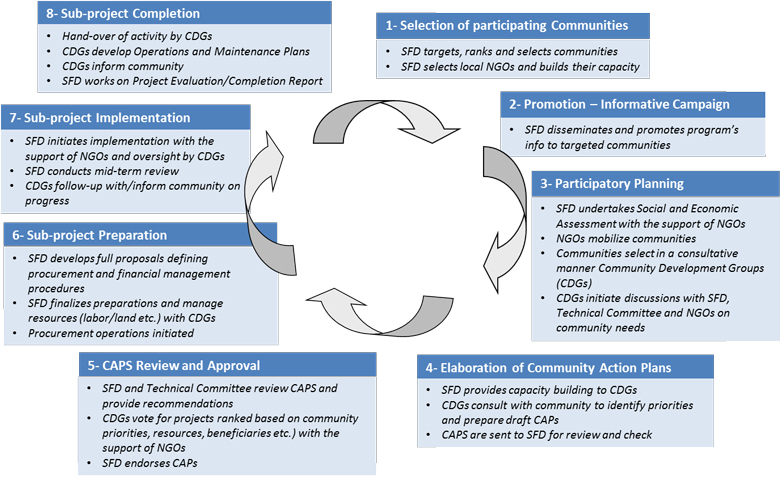The Social Fund for Development (SFD) is a new program that seeks to improve the living conditions and opportunities for the poor and vulnerable in Iraq by improving their access to basic essential services and generating short-term employment opportunities at the community level.
The overarching goal of the SFD is to deepen stabilization efforts in Iraq, restore citizen-state trust, and institute measures to strengthen social cohesion and local development priorities.
Community subprojects are expected to have a positive social impact through increased empowerment and social cohesion through bringing diverse community constituents together to think about common priorities and needs in their community.
What kind of activities will be financed and executed by the SFD?
The SFD will finance subprojects identified by the community that are technically feasible, financially viable and socially justified. Such subprojects consist of small scale economic and social infrastructure representing priority investments for the community, based on an open menu that typically includes investments that improve access to basic public services, and investments that can be realized using labor-based techniques and maximizing the use of local materials.
Sub-projects will be simple, avoid administrative complexity and have no negative environmental impacts. The work will start in specific sectors, such as education, health, agriculture and irrigation, and access to markets. Priority will be given to sub-projects that benefit the poorest part of the population and special needs groups, as well as subprojects that create permanent employment. For instance, small scale water supply, rehabilitation of small reservoir, school room construction, pedestrian walk, etc. The maximum subproject cost is about US$200,000.
How will national roll-out take place?
In 2018, the SFD activities will start in three governorates: Muthanna, which has the highest poverty rate, Salahideen, as a liberated area with many returnees, and Dohuk, where host communities were significantly impacted by internally displaced people (IDPs) and Syrian refugees. In 2019, the program will expand to Ninawa, Thiqar, Qadisiya, and Baghdad. Starting year 3, the program will expand to all governorates in Iraq. Within the governorates, communities will be ranked based on indicators that best capture the pertinent dimensions of poverty, level of deprivation in the governorate, in addition to population.
How will the subprojects be managed?
The Ministry of Planning will manage the SFD through the Project Management Office (PMO) in the first two years, working with Project Management Teams (PMT) in the governorates. These teams will provide general and specific support to communities to help achieve the objective of the SFD. Both PMO and PMTs will have the following functions: Management/oversight, social and community development, communications, procurement, finance, monitoring and evaluation, social and environmental safeguards.
NGOs will also play a key role in helping the communities to organize themselves and identify their priorities and needs, as well as in executing the activities on the ground.
The SFD positions local communities at the center of the planning and execution process, with specific interventions for engaging and benefiting vulnerable groups, namely women. Community Development Groups (CDGs) will be formed in a consultative manner, representing various community stakeholders, including women. NGOs will work with CDGs and the SFD technical teams on preparing Community Action Plans (CAPs), which lay out the community’s vision of needs and priorities, as well as of the interventions required in various sectors, as well as on getting approvals and funding, organizing resources, implementing, and monitoring.
What will the SFD subproject Implementation cycle look like?
The subproject cycle is initiated at the community level. The CDGs, with the support of the SFD governorate local office and NGOs, will identify the CAPs based on a social and economic assessment carried out at the local level. The CAP is then sent forward to the SFD local governorate office, who would discuss it with local government and the sectoral ministries, to ensure consistency with overall governorate development plans and national standards, and avoid any duplication.
Once CAPs are approved, the community votes on the priorities based on the funding allocated to that community. Once voted on and agreed, the SFD local governorate office would assume all implementation related aspects, including procurement, financial management, and safeguards aspects, in close coordination with local government and sectoral ministries. Community members will benefit from continuous advice, hand-holding and capacity building as needed throughout the whole process.

